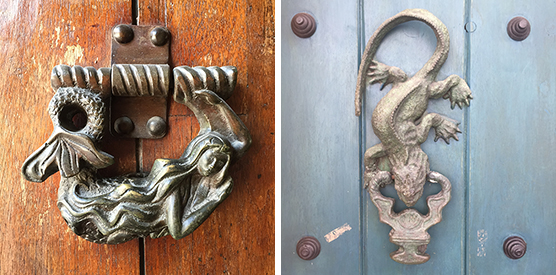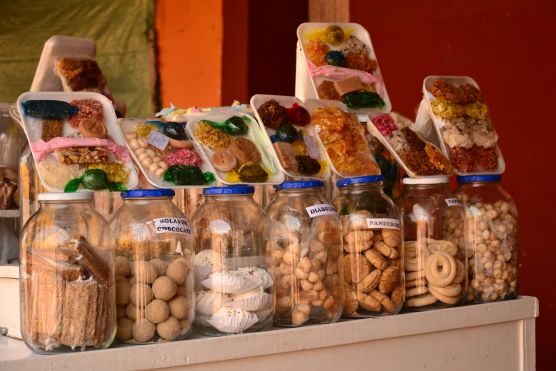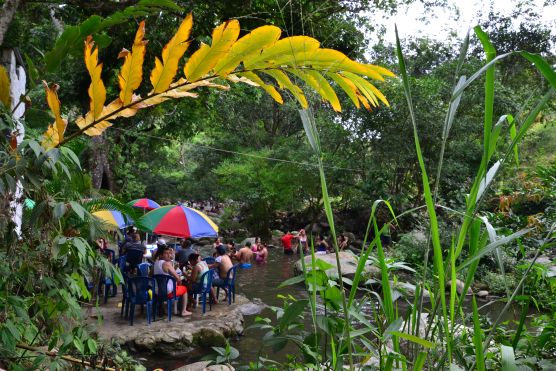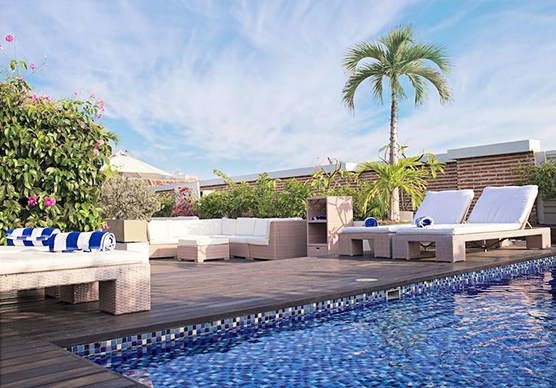In many ways, Colombia continues to be an undiscovered and underrated destination for travelers. Having built up a bad reputation for itself over many years, it’s starting to shed its former skin and step into the limelight as the beautiful debutante it always was.
The colonial city of Cartagena is the perfect place from which to start your explorations of this bountiful region. Designated a UNESCO World Heritage Site for boasting the most extensive fortifications of South America, much of its charm can be extracted from a stroll around its historic center. But that’s not all; the coastal city is surrounded by soaring summits, wild jungle and unspoiled beaches that haven’t been destroyed by tourism in the same way that other South American destinations have. Whether you’re in need of some R&R or are looking for adventure, you’ll find it here. Prepare to be surprised.
1. The Casablanca B&B
Photo courtesy of Casablanca B&B
The Casablanca B&B is a hotel you will look forward to returning to at the end of the day, even if that means your Cartagena explorations have come to an end. However, if you can’t stay here, you should at least pop by or get a day pass to check out its charm. Situated within the walls of the historic center, the interior was designed by a prestigious Bogotá-based architecture firm who preserved much of the original colonial architecture. Minimal interventions keep the space at once utterly modern and authentically ancient, with all the walls and surfaces painted white to contrast against the rainbow of colors on the streets outside. The roof terrace provides a chilled, private spot for sunbathing and reading away from the crowds, and the rooms are airy with an emphasis on space. Fresh papaya, passion fruit and pineapple are served for breakfast along with eggs and local delicacies. Oh, and did we mention the hotel boasts not one but two pools? One on the roof and one in the courtyard.
2. Doorknockers in the Old Town

Stroll around the Old Town for just a few minutes and you’ll notice something peculiar about the entrances to the colonial buildings lining the narrow streets. The gigantic wooden doors inlayed into its colorful facades are adorned with a striking variety of symbols. From lizards and lions to mermaids and bearded dragons, Cartagena’s doorknockers are just as captivating as its locals. Once you spot one, you’ll see them everywhere you go in the El Centro area. The metalwork has been immaculately preserved so that its ornate intricacy is visible from afar. Once an emblem of status, the doorknocker designs originate from the medieval era, when social hierarchies were clearly defined. Status was conveyed through size and shape. A lizard was a sign of royalty, while the mermaid likely belonged to a family of the merchant class. Nowadays they make great content for your Instagram.
3. Getsemani
Once a no-go zone for travelers, Getsemani has cleaned up its act and reinvented itself as the city’s most diverse neighborhood. Wander down narrow streets of colorful houses, admire the street art and watch children play a ferocious game of soccer in the shadow of a 17th century church. Plaza de la Trinidad is its beating heart; locals and travelers alike congregate here every night to watch performers, snack on warm empanadas and enjoy the cool breeze under the stars. The city’s trendiest bars can be found on the arteries coming off the square; once you’ve warmed up with a mojito or two, head to legendary live music club Café Havana, a former rundown warehouse that retains much of its weathered origins. Between the unrelenting salsa and potent cocktails, you’re guaranteed to spin faster than the ceiling fan in your hotel bedroom.
4. Restaurante Carmen

With the Caribbean coast at arm’s length and a rich tapestry of cultures woven into its fabric over the centuries, Cartagena’s food scene is exceptional. Street food staples such as arepas and tamales can be picked up on any corner, but for something truly special book a table at Carmen. Housed inside a renovated colonial house with an outdoor courtyard, you’ll dine in the shade of palm trees. As for the food, prepare to experience taste sensations like never before. Sweet and sour flavors, smooth and crisp textures and vibrant colors collide on the plate in perfect balance. The familiar is given a twist, so every mouthful is a surprise. Sea bass ceviche, plancha seared snapper, coconut sea foam and chorizo salt make up just a snippet of the inspired menu.
5. Ábaco Libros y Café

Photo courtesy of Ábaco Libros y Café
Right in the middle of El Centro is a little bookshop full of resources on local culture and much more. Shelves are piled high with literary classics, recent publications and travel guides, but the best resource of all is the eccentric owner. She’ll happily answer any questions you have about her favorite city in the world (guess where it is) over a glass of wine or cup of coffee. She’ll tell you about a dream she had 13 years ago of having a cultural place by the sea and how it became her reality. An atmosphere of studious calm merges with one of intellectual buzz most days and nights, though during important events, such as the Copa America or live concerts, it heats up as patrons clink beer bottles, exchange opinions and shout at the screen.
6. Portal de Los Dulces

In the beautiful Plaza de la Aduana, the largest square in Cartagena, a sweet surprise awaits you under the arches. A strip of vendors selling traditional Colombian candies occupies the whole walkway, large jars filled with colorful treats in all shapes and sizes lining the wall. This is a great place to try some local delicacies and a must-visit for anyone with a sweet tooth. Most candies come in bar or bite form and are made with shredded coconut that’s set in either condensed milk, golden syrup or panela (unrefined whole cane sugar), although some family recipes call for additional spices like cinnamon. These pillowy little mounds are made fresh every morning and sold by weight. Other biscuit-style offerings include cassava and coconut—chocolate and milk biscuits in the shape of mummies, dolls and humans.
7. Minca

Escape the oppressive heat of the city and head for the hills. To get there, you’ll most likely have to squeeze onto a collectivo (shared taxi) but after just 45 minutes you’ll arrive in Minca, a small village in the Sierra Nevada mountain range. Known for its organic coffee, it’s the perfect rural respite to relax and recharge for a few days. Much of the natural landscape is completely unspoiled, allowing visitors to feel fully immersed in its vegetation. The mountains offer numerous hiking routes for all levels of ability, and you’ll be rewarded with beautiful waterfalls, rivers and natural pools to cool off in before starting the journey back. The friendly locals will be more than happy to tell you all about how the famed Colombian coffee is made. Other activities include bird watching, mountain biking and rafting, but don’t forget to set aside a few hours in the hammock.
Zosia Swidlicka is a traveler that writes. With homes all over Europe, she is currently based in Brooklyn, New York.
